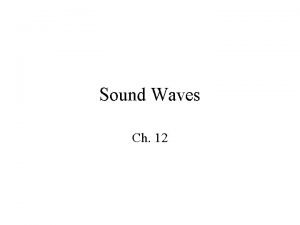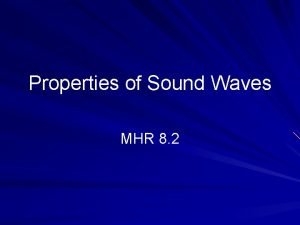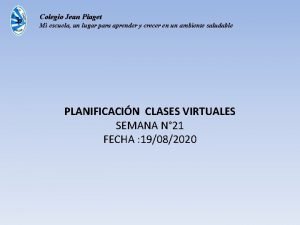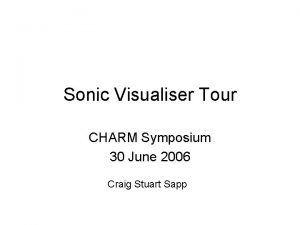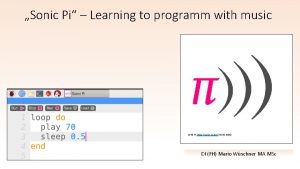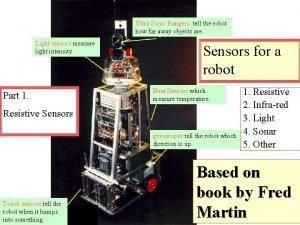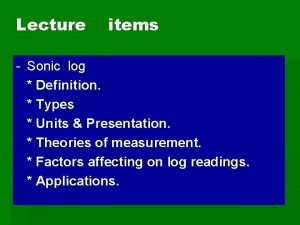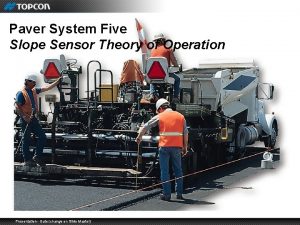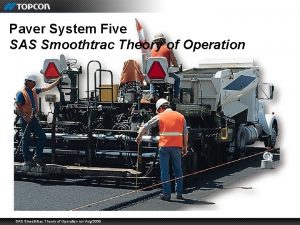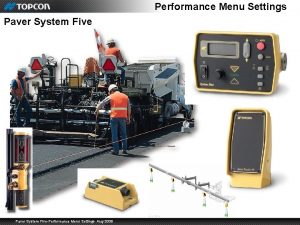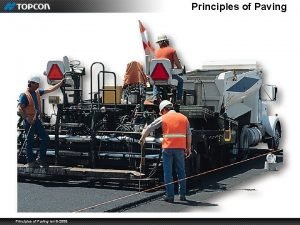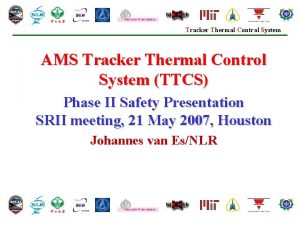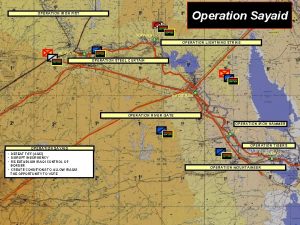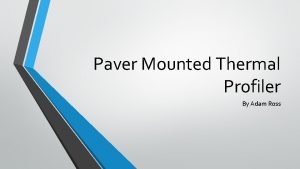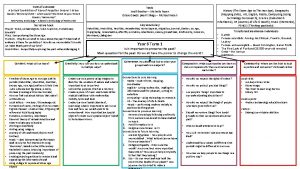Sonic Tracker Theory of Operation Paver System Five



























- Slides: 27

Sonic Tracker Theory of Operation Paver System Five Sonic Tracker Theory of Operation – rev Aug 2009

Sonic Tracker Control • The Sonic Tracker controls grade, or the mat thickness • The Tracker can use any physical grade reference to control the mat thickness. Sonic Tracker Theory of Operation – rev Aug 2009

Track a Curb The Tracker can be positioned to control thickness referencing a curb. Sonic Tracker Theory of Operation – rev Aug 2009

Track an existing mat The Tracker can be positioned to control paving thickness referencing an existing mat. Sonic Tracker Theory of Operation – rev Aug 2009

Track an elevated stringline The Tracker can track an elevated stringline. The mat thickness will be controlled as the Sonic Tracker follows the stringline that has been set to the desired grade. Sonic Tracker Theory of Operation – rev Aug 2009

Track a Surface Stringline The Sonic Tracker can even control grade from a Surface Stringline. Sonic Tracker Theory of Operation – rev Aug 2009

Sonic Tracker Function • The Tracker sends sound pulses 39 times per second. • The sounds waves bounce off of any physical object • The sound echo returns to the Tracker • The Tracker measures the time, and therefore the distance to the reference. Sonic Tracker Theory of Operation – rev Aug 2009

Sonic Tracker Function • Think of the Tracker as a stopwatch Distance = (Time)(Speed of sound) Sonic Tracker Theory of Operation – rev Aug 2009

Working Window Slow Flashing Arrow (No Grade Correction) String SOLID UP ARROW. 15’ (4. 5 cm) FLASHING UP ARROW. 05’ (1. 5 cm) Working Window . 2’ (6 cm) ON GRADE. 01 (3 mm) FLASHING DOWN ARROW. 05’ (1. 5 cm) SOLID DOWN ARROW. 15’ (4. 5 cm) Slow Flashing Arrow (No Grade Correction) Sonic Tracker Theory of Operation – rev Aug 2009

Working Window Slow Flashing Arrow (No Grade Correction) SOLID UP ARROW. 15’ (4. 5 cm) String Working Window FLASHING UP ARROW. 05’ (1. 5 cm) . 2’ (6 cm) ON GRADE. 01 (3 mm) FLASHING DOWN ARROW. 05’ (1. 5 cm) SOLID DOWN ARROW. 15’ (4. 5 cm) Slow Flashing Arrow (No Grade Correction) Sonic Tracker Theory of Operation – rev Aug 2009

Sonic Tracker Function • Screed is at the desired mat thickness • Tracker is set to On-Grade. • On-Grade is represented by a specific distance from the Tracker to the grade reference. • The Tracker sets the “stopwatch” to a specific time representing On-Grade Sonic Tracker Theory of Operation – rev Aug 2009

Sonic Tracker Function • If the Tracker raises, the distance to the grade reference has increased. • The time for the echo to return to the Tracker also increases. • The Tracker indicates a lower signal. Sonic Tracker Theory of Operation – rev Aug 2009

Sonic Tracker Function • If the Tracker lowers, the distance to the grade reference has decreased. • The time for the echo to return to the Tracker also decreases. • The Tracker indicates a raise signal. Sonic Tracker Theory of Operation – rev Aug 2009

Sonic Tracker Function • If the Tracker receives an echo indicating the Tracker is more than 2 ½” (. 2’) above the grade reference, an ‘out of working window’ signal is displayed. • Slow-flashing down arrow • System Five does not send a valve output. Sonic Tracker Theory of Operation – rev Aug 2009

Sonic Tracker Function • If the Tracker receives an echo indicating the Tracker is less than 2 ½” (. 2’) from above the grade reference, an ‘out of working window’ signal is displayed. • Slow-flashing up arrow • System Five does not send a valve output. Sonic Tracker Theory of Operation – rev Aug 2009

Sound Wave Pattern • The sound waves come out of the Tracker in a cone shape. • At a distance of 24” from the bottom of the Tracker, the cone should be about 6” in diameter. Sonic Tracker Theory of Operation – rev Aug 2009

Working Distance • The closest working distance = 14” • The farthest working distance = 55” • Recommended height for Paving applications = between 14” and 24”. • “Rule of Thumb” for paving; Double the bail distance = 18” Sonic Tracker Theory of Operation – rev Aug 2009

Temperature Bail Function • The Temperature Bail acts as a reference for the dramatic, rapid changes in temperature and humidity that occur in paving applications. Sonic Tracker Theory of Operation – rev Aug 2009

Sonic Tracker Setup • Recommended height for Paving applications is between 14” and 24”. • “Rule of Thumb” good starting point for setup: Double the Bail Distance = 18” 14” to 24” Sonic Tracker Theory of Operation – rev Aug 2009 9” 18”

Sonic Tracker Setup • Recommended height for Paving applications is between 14” and 24”. • “Rule of Thumb” good starting point for setup: Double the Bail Distance = 18” Sonic Tracker Theory of Operation – rev Aug 2009

Temperature Compensation • Dramatic, rapid temperature changes • Gusty wind blowing over hot mix Temperature Bail compensates for temperature changes here No compensation for temperature changes here Sonic Tracker Theory of Operation – rev Aug 2009

Sonic Tracker Setup • Gusty wind blowing over hot mix • Dramatic, rapid temperature changes üTracker displaying erratic grade lights üTracker feels hot! Lower the Tracker! No temperature compensation ü Minimize the atmosphere between the Tracker bail and the grade reference Sonic Tracker Theory of Operation – rev Aug 2009

Sonic Tracker Setup Tracking a mechanical ski • If a string or wire is used, keep the string at least 4” (10 cm) above the ski • Mechanical skis commonly shift sideways – the Tracker will be out of the Working window” Sonic Tracker Theory of Operation – rev Aug 2009

Sonic Tracker Setup Tracking a mechanical ski • Beam surging will cause the ski to move a few inches underneath the Tracker • Upon startup, center the Tracker between shoe bolts CENTER Sonic Tracker Theory of Operation – rev Aug 2009

Sonic Tracker Setup Tracking a mechanical ski • Center the Tracker on the entire ski d 1 Sonic Tracker Theory of Operation – rev Aug 2009 = d 2

Sonic Tracker Setup Tracking a mechanical ski • Center the Tracker on the entire ski • Proper placement giving 30’ averaging d 1 15’ Sonic Tracker Theory of Operation – rev Aug 2009 = d 2 15’

Sonic Tracker Theory of Operation Paver System Five Sonic Tracker Theory of Operation – rev Aug 2009
 Ironsmith tree grates
Ironsmith tree grates Sonic spectrum definition
Sonic spectrum definition Sonic wave mhr
Sonic wave mhr The beat created by the sounds of the words in a poem
The beat created by the sounds of the words in a poem Sound figurative language
Sound figurative language Soniq mq
Soniq mq Sonic animado gif
Sonic animado gif Ultrasonic vs sonic
Ultrasonic vs sonic Sonic visualiser tutorial
Sonic visualiser tutorial Sonic images
Sonic images Sonic rush adventure review
Sonic rush adventure review Sonic the hedgehog
Sonic the hedgehog Sonic the hedgehog
Sonic the hedgehog Gates sonic tension meter 507c
Gates sonic tension meter 507c Sonic in slaton
Sonic in slaton Sonic pi portable
Sonic pi portable Sonic rangers 4chan
Sonic rangers 4chan Sonic islamic
Sonic islamic Progress sonic esb
Progress sonic esb Sonic restaurant swot analysis
Sonic restaurant swot analysis Sonic log ppt
Sonic log ppt Linear mechanical motion
Linear mechanical motion Sonic boom
Sonic boom Arby's menu
Arby's menu High challenge fire wall
High challenge fire wall Sonic pi variables
Sonic pi variables Sonic esb
Sonic esb Sonic esb
Sonic esb

